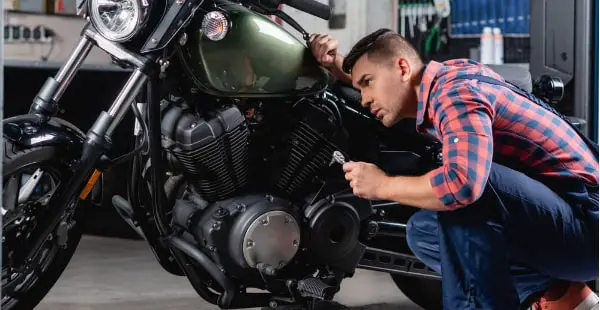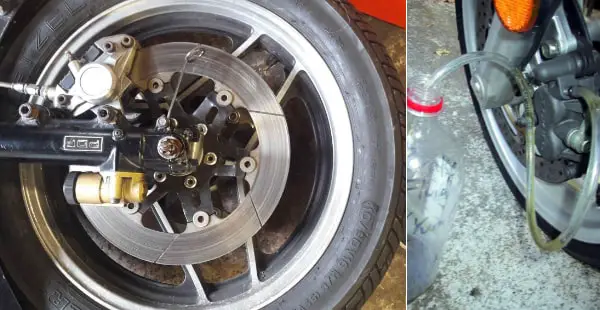Hello to all the bikers out there!
If you use dirt motorcycles, Quad bikes, or any other motorized vehicle, you will almost certainly need to bleed the brakes at some point. Wondering how to bleed motorcycle brakes?
Getting a good brake bleeding kit and knowing all the steps is enough to perform the task by yourself.
Now, you may ask, why should I bleed my motorcycle brakes? The first thing you’ll get if you don’t bleed your motorcycle brakes is non-responsive brakes. Even if they do, it won’t be enough.
All of these will result in brake failure. In case of an emergency while riding, you’ll fail to stop your bike. And this is how you’ll break your bones! You don’t want that, do you?
So today, I’m here with a few pointers and methods to explain everything about bleeding motorcycle brakes.
When Should You Bleed Your Motorcycle Brakes?

People often ignore taking care of the brake system. Make sure to replace the old parts as you need. Routinely checking and refilling the brake fluid is also a vital task. Now, why do you need to bleed your motorcycle brakes?
Well, less power in the brakes, irregular braking, and sponginess in the lever are signs that you need to bleed your brakes.
When you see any of these signs, you’ll know that it’s time to bleed the brakes.
How Do You Bleed Motorcycle Brakes by Yourself?
Before I get into the details for motorcycle brake bleeding, let’s talk about brake fluid.
What actually is brake fluid? Well, it’s a fluid used in the hydraulic brakes of vehicles. You’ll also find it in clutch applications. Brake fluid converts force into pressure and amplifies braking power.
Simply put, when you push one foot on the brake pedal, braking fluid converts this energy into pressure on brakes.
Now, off to brake bleeding! I’ll discuss all how to bleed motorcycle brakes from empty tanks in this step-by-step guide.

- The first step in the brake bleeding process is to detach the reservoir lid and then load the reservoir. You should scatter absorbing clothes around the reservoir to mop up any leakage. Keeping the paintwork free of spills is absolutely vital!
- Now, install a rubber sealed diaphragm under the reservoir top. What does it do? Well, it separates the brake fluid from surroundings.
- Dump some brake fluid into the bleed bottle using a 60cc plastic syringe as well. And make sure the outlet pipe is under the fluid’s level. Put the wrench on on the brake caliper trailed by the rubber hose.
- You should get a new bottle of brake fluid while bleeding the brakes. Avoid using an old one.
- You’re done with the process when you have a full reservoir. When the system is empty, lift the bleed nipple approximately a third of the way. Press the lever periodically to deliver fluid into the brake hose.
Ahoy, there’s something you should keep in mind! You have to continuously top out the fluid reservoir throughout the process to stop air from accessing the system.
- When the brake lever is pushed, you’ll find a stream of air bubbles emerging from the tip, just below the fluid level. It happens as the fresh fluid forces air out of the system.
- Now, push and hold the brake lever in place. Then, reopen the bleed nipple, and repeat the pumping process. While the lever is still in place, open the bleed nipple and close it again. Keep doing this until you see no air bubbles escaping the bleed tube’s end.
Tip: Brake caliper can contain more than one bleed nipple. While bleeding a system, start the process with the nipple farthest from the reservoir.
When you’re done, the lever should feel solid when push force, with zero sponginess.
Why Is There No Pressure in My Brake Pedal?
Well, that’s a question worth exploring! I can’t end this guide without discussing one of the prominent problems bleeding motorcycle brakes.
You’ll get no pressure in the bike pedals if the brake pads aren’t working properly. Let’s see why it could happen.
If there’s air in your motorcycle brake systems, the brake pedal will not get enough pressure. Also, don’t forget to check the brake fluid reservoir. Make sure that the bike brake fluid has reached the mark.
Now, how do you solve getting no pressure in the brake pads?
You might see in your service manual to let the motorcycle rest for two hours if there is no pressure after brake bleeding.
To solve the no-pressure issue, you can start with the rear brakes. Bleed the banjo bolt near the master cylinder and pump it a few times.
Tighten up the banjo fitting bolt again after cracking it loose. Keep the brake fluid-filled and the reservoir cover off. Repeat a few times.
Then move to the banjo at the caliper end. Bleed at the bleeder screw, repeat 4-5 times.
Tip: You can also try tying the front brake lever with the grip. Hang something heavy like a cement block off the rear brake. This should help with the bleeding brakes no pressure issue.
How Do You Bleed ABS on Motorcycle Brakes?
If you’ve recently installed stainless steel brake lines, then you have to know about bleeding motorcycle brakes with ABS.
You can bleed your ABS-equipped motorcycle by yourself just as you would with any other bike. First, you have to put pressure on the system. Then, open the bleed valve. The lever will feel lighter once the engine oil enters the pipe. Close the bleed fittings and keep doing it till you bleed your motorcycle brakes with ABS.
A lot of modern-day motorcycles come with ABS. Some ABS-equipped bikes might not bleed the usual way. For such vehicles, the ABS vacuum pump must be linked into something like a computer and pass through a particular bleed process. You might visit a professional mechanic to do it.
Make sure to read the service manual to find out what you need to do.
Reverse Bleeding Motorcycle Brakes
Reverse bleeding uses the bleed hose through brake fluid flushing with improved caliper pistons. It ensures practically minimal resistance.
Bleeder valve, metering valve, proportioning valve, and anti-lock valves are supposed to obstruct the clean brake fluid from enter the brake master cylinder.
The rear brake reservoir receives pressure during pressure bleeding. Once the bleeder valves are opened, pressurized fluid and air are pushed out of the valves.
The brake setups draw fresh brake fluid from the rear brake reservoir by this negative pressure. The purpose of reverse bleeding is to let all the air out of the parts before installing them.
Frequently Asked Questions
Why won’t my motorcycle brakes bleed?
Answer: The lowered caliper will stop motorcycle brake bleeding. If the side of the caliper is lower than the rear brake fluid reservoir, then the brake bleeder won’t work.
How do you bleed dual disc brakes on a motorcycle?
Answer: First, put pressure on the bleed valve. Open the vacuum pump and the brake bleeder. Let the air go out by holding down the brake bleed nipple. Close the brake bleeder and let the vacuum pump and brake pads return to their positions.
Keep repeating it until your brake job is done.
How long does it take to bleed motorcycle brakes?
Answer: With a proper brake line kit, it will take 30 minutes to bleed motorcycle brakes. If you see bubbles during brake bleeding, you have to replace cheap brake lines. The process would take longer then.
Why are brakes still spongy after bleeding?
Answer: If you didn’t properly bleed your brake, it’s common to get spongy brakes. Simply put, it greatly depends on your brake fluid as well. If the fluid is contaminated, you’ll end up with spongy brakes. It will let moisture or air enter the brake components.
Do you bleed brakes with engine on or off?
Answer: If you’re bleeding the ABS system, then you have to keep your engine on. But, to bleed the base braking system, you don’t need to keep the engine on.
What brake fluid should I use?
Answer: Silicone-based fluid is best for satisfactory brake performance. Glycol-based fluid is quite popular these days. Try out DOT4-spec glycol fluid for the best results.
Final Thoughts
Back bleeding motorcycle brakes are regular motorcycle maintenance that you should execute at least once a year.Also, remember to change the brake fluid to ensure fewer issues with the braking system.
The color of the brake fluid should be a clear sign of its age. Newer brake fluids will be amber-colored. The older it is, the darker the color would be.
Also, make sure that the brake pads aren’t worn out. If they are, they’ll start to respond less and eventually lead to brake failure.
If you use fresh brake fluid, and bleed the brakes regularly, then you’ll always be much ahead on the overall motorcycle maintenance. I hope this guide on how to bleed motorcycle brakes was helpful to you!
